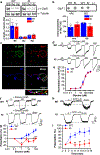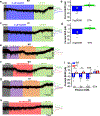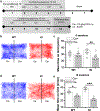Influence of nonsynaptic α1 glycine receptors on ethanol consumption and place preference
- PMID: 30884072
- PMCID: PMC6751026
- DOI: 10.1111/adb.12726
Influence of nonsynaptic α1 glycine receptors on ethanol consumption and place preference
Abstract
Here, we used knock-in (KI) mice that have ethanol-insensitive alpha 1 glycine receptors (GlyRs) (KK385/386AA) to examine how alpha 1 GlyRs might affect binge drinking and conditioned place preference. Data show that tonic alpha 1 GlyR-mediated currents were exclusively sensitive to ethanol only in wild-type mice. Behavioral studies showed that the KI mice have a higher intake of ethanol upon first exposure to drinking and greater conditioned place preference to ethanol. This study suggests that nonsynaptic alpha 1-containing GlyRs have a role in motivational and early reinforcing effects of ethanol.
Alcohol abuse leads to great medical, social, and economic burdens throughout the world. It is believed that the rewarding actions of alcohol are mediated by alterations in the mesolimbic dopaminergic system leading to increased levels of dopamine in the nucleus accumbens (NAc). Little is known about the role that ligand-gated ion channels (LGICs), such as glycine receptors (GlyRs), have in regulating levels of ethanol intake and place preference. In this study, we used knock-in (KI) mice that have ethanol-insensitive α1 GlyRs (KK385/386AA) and a combination of electrophysiological and behavioral approaches to examine how expression of ethanol-resistant α1 GlyRs in brain neurons might affect binge drinking and conditioned place preference. Data show that tonic α1 GlyR-mediated currents that modulate accumbal excitability were exclusively sensitive to ethanol only in wild-type (WT) mice. Behavioral studies showed that the KI mice have a higher intake of ethanol upon first exposure to drinking and greater conditioned place preference to ethanol, suggesting that α1 GlyRs in the brain have a protective role against abuse. This study suggests that nonsynaptic α1-containing GlyRs have a role in motivational and early reinforcing effects of ethanol and open a novel opportunity for pharmacotherapy development to treat alcohol use disorders.
Keywords: G-protein; alcohol and alcoholism; animal models; glycine receptor; nucleus accumbens; receptor pharmacology.
© 2019 Society for the Study of Addiction.
Figures






Similar articles
-
Altered sedative effects of ethanol in mice with α1 glycine receptor subunits that are insensitive to Gβγ modulation.Neuropsychopharmacology. 2014 Oct;39(11):2538-48. doi: 10.1038/npp.2014.100. Epub 2014 May 7. Neuropsychopharmacology. 2014. PMID: 24801766 Free PMC article.
-
Reduced sedation and increased ethanol consumption in knock-in mice expressing an ethanol insensitive alpha 2 subunit of the glycine receptor.Neuropsychopharmacology. 2021 Feb;46(3):528-536. doi: 10.1038/s41386-020-0689-9. Epub 2020 May 1. Neuropsychopharmacology. 2021. PMID: 32357359 Free PMC article.
-
Presence of ethanol-sensitive glycine receptors in medium spiny neurons in the mouse nucleus accumbens.J Physiol. 2017 Aug 1;595(15):5285-5300. doi: 10.1113/JP273767. Epub 2017 Jun 23. J Physiol. 2017. PMID: 28524260 Free PMC article.
-
Ethanol effects on glycinergic transmission: From molecular pharmacology to behavior responses.Pharmacol Res. 2015 Nov;101:18-29. doi: 10.1016/j.phrs.2015.07.002. Epub 2015 Jul 6. Pharmacol Res. 2015. PMID: 26158502 Free PMC article. Review.
-
Molecular targets and mechanisms for ethanol action in glycine receptors.Pharmacol Ther. 2010 Jul;127(1):53-65. doi: 10.1016/j.pharmthera.2010.03.003. Epub 2010 Apr 23. Pharmacol Ther. 2010. PMID: 20399807 Free PMC article. Review.
Cited by
-
Changes in neuronal excitability and synaptic transmission in nucleus accumbens in a transgenic Alzheimer's disease mouse model.Sci Rep. 2020 Nov 11;10(1):19606. doi: 10.1038/s41598-020-76456-w. Sci Rep. 2020. PMID: 33177601 Free PMC article.
-
High ethanol sensitive glycine receptors regulate firing in D1 medium spiny neurons in the nucleus accumbens.Neuropharmacology. 2019 Dec 1;160:107773. doi: 10.1016/j.neuropharm.2019.107773. Epub 2019 Sep 12. Neuropharmacology. 2019. PMID: 31521620 Free PMC article.
-
Changes in the Properties of Ethanol-Sensitive Molecular Targets During Maturation and Aging.Adv Exp Med Biol. 2025;1473:299-316. doi: 10.1007/978-3-031-81908-7_13. Adv Exp Med Biol. 2025. PMID: 40128484 Review.
-
Modulatory Actions of the Glycine Receptor β Subunit on the Positive Allosteric Modulation of Ethanol in α2 Containing Receptors.Front Mol Neurosci. 2021 Nov 18;14:763868. doi: 10.3389/fnmol.2021.763868. eCollection 2021. Front Mol Neurosci. 2021. PMID: 34867189 Free PMC article.
-
Aging in nucleus accumbens and its impact on alcohol use disorders.Alcohol. 2023 Mar;107:73-90. doi: 10.1016/j.alcohol.2022.08.004. Epub 2022 Sep 7. Alcohol. 2023. PMID: 36087859 Free PMC article. Review.
References
-
- Aguayo LG, Castro P, Mariqueo T, Munoz B, Xiong W, Zhang L, Lovinger DM, Homanics GE (2014) Altered sedative effects of ethanol in mice with alpha1 glycine receptor subunits that are insensitive to Gbetagamma modulation. Neuropsychopharmacology : official publication of the American College of Neuropsychopharmacology 39:2538–2548. - PMC - PubMed
-
- Aguayo LG, Tapia JC, Pancetti FC (1996) Potentiation of the glycine-activated Cl- current by ethanol in cultured mouse spinal neurons. The Journal of pharmacology and experimental therapeutics 279:1116–1122. - PubMed
-
- Badanich KA, Mulholland PJ, Beckley JT, Trantham-Davidson H, Woodward JJ (2013) Ethanol reduces neuronal excitability of lateral orbitofrontal cortex neurons via a glycine receptor dependent mechanism. Neuropsychopharmacology : official publication of the American College of Neuropsychopharmacology 38:1176–1188. - PMC - PubMed
Publication types
MeSH terms
Substances
Grants and funding
LinkOut - more resources
Full Text Sources
Medical
Molecular Biology Databases

